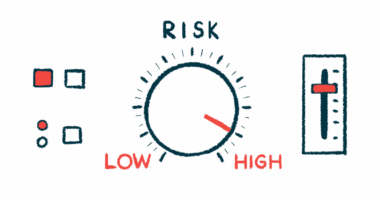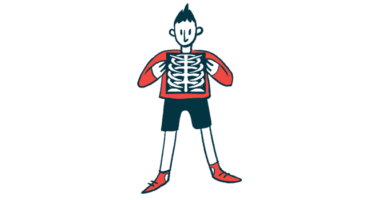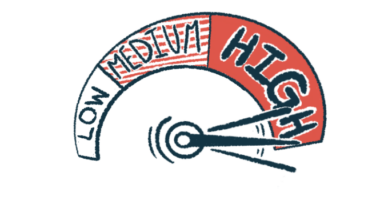Risk of blood clots higher with Cushing’s vs. other pituitary tumors
Findings of UK study highlight need for 'rigorous' preventive therapy

People with Cushing’s disease are at a higher risk for certain types of blood clots than individuals with other forms of pituitary gland tumors, a U.K. study found.
Specifically, for example, the risk of clotting complications was more than 40 times higher among those with Cushing’s disease than for people with nonfunctioning pituitary adenomas, or NFPAs, in a final analysis.
Among Cushing’s patients, the study found, blood clot-related problems commonly occurred within a year of diagnosis, or shortly after surgery to treat the disease, known as the perioperative period.
“These findings provide further evidence of the need for rigorous thromboprophylaxis [treatment to prevent blood clots] in patients with CD [Cushing’s disease] from the time of diagnosis and subsequently throughout the perioperative period,” the researchers wrote.
The study, “Venous thromboembolism in patients with pituitary adenoma: UK multicentre cohort study,” was published in the European Journal of Endocrinology.
People with Cushing’s disease experience symptoms related to elevated levels of the hormone cortisol in the body; this is due to tumors on the brain’s pituitary gland, called pituitary adenomas.
These tumors are not cancerous, but they do produce too much adrenocorticotropic hormone, which then signals the adrenal glands, which sit atop the kidneys, to make more cortisol than they should.
There are also other types of pituitary adenomas. Some of them overproduce growth hormone, leading to a condition called acromegaly, which is characterized by the irregular growth of certain tissues in the body. Others, such as NFPAs, don’t overproduce hormones and may only cause symptoms if they’re pressing on other structures.
Venous thromboembolism, or VTE, a known risk for Cushing’s patients
People with Cushing’s disease are at an increased risk of venous thromboembolism (VTE), in which blood clots in the veins impair normal blood flow. Among potential complications are deep vein thrombosis, where the clot is stuck in the deep veins — often the legs — and pulmonary embolism, a life-threatening condition in which the clot travels to the lungs.
Data are lacking, however, on the relative risk of these complications in people with Cushing’s disease compared with individuals who have other types of pituitary adenomas.
To learn more, scientists from the University of Birmingham and other institutions retrospectively analyzed the incidence of VTE among a large group of people diagnosed with acromegaly, Cushing’s disease, or NFPA. These patients were seen at three centers in the U.K., beginning up to four years prior to their diagnosis.
Of 827 people included in the analysis, most had NFPA (60.7%), followed by acromegaly (26.4%), and Cushing’s disease (12.9%). Most of these patients (92.9%) underwent at least one tumor removal surgery.
Over a median of 13.4 years, 20 had a VTE event. Among them, 12 had Cushing’s disease (11.2%), six had acromegaly (2.7%), and two had NFPA (0.4%).
Risk of blood clots 45 times higher in Cushing’s than with NFPA
Individuals with Cushing’s were significantly more likely to have one of these blood clotting complications than people in either of the other two groups. In fact, people with Cushing’s were found to be at about a 21-times higher risk than people with NFPA, and a 4.5-times higher risk than those with acromegaly.
Most of the recorded VTE events in the Cushing’s group were classified as pulmonary embolism and occurred within a year of the Cushing’s diagnosis.
For four people, these events occurred shortly after pituitary surgery — a period known to be associated with an elevated blood clot risk. However, VTEs were also recorded at other times, including in two people who were in stable disease remission years after surgery, the data showed.
In final statistical analyses adjusted for factors such as sex and age, Cushing’s diagnosis was found to be an independent risk factor for VTE, raising the risk by more than 45 times relative to the NFPA reference group.
Diabetes and a prediabetic state called impaired glucose tolerance were also independent risk factors for VTE.
“We have demonstrated a significantly heightened risk of VTE in patients with CD in comparison to those with NFPA … or acromegaly,” the researchers wrote.
Future research should focus on establishing the optimal regimen for thromboprophylaxis [treatment to prevent blood clots] including whether this should be long term versus a limited period post diagnosis, and, if any specific thrombophylactic agent is superior to others.
The scientists noted that while thromboprophylaxis is routinely given to people considered to be at an increased VTE risk, this practice “is not yet widely established” in the context of Cushing’s disease.
Expert guidelines published earlier this year recommend that such treatments be considered in Cushing’s patients at the time of diagnosis and continued for at least three months after biochemical disease remission is achieved.
“Future research should focus on establishing the optimal regimen for thromboprophylaxis including whether this should be long term versus a limited period post diagnosis, and, if any specific thrombophylactic agent is superior to others,” the team wrote.
The researchers also noted that additional studies to better understand why VTE risk is elevated among people with Cushing’s would further inform the best treatment approach.








